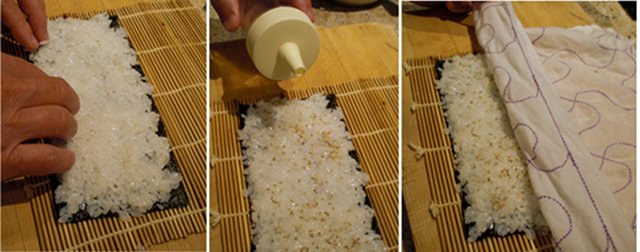When I posted tekkamaki 鉄火巻き, I said that I often make California roll. My wife corrected this statement by reminding me that I have not made this for ages. So here it is. This was the shime 締め dish for the evening. We also had some leftover smoked salmon (just enough to make two nigiri) so I made two smoked salmon nigiri sushi or nigirizushi にぎり寿司.
This time, I recruited my wife to take the pictures so that I can show each step, (although anybody in their right mind should not follow my instructions for this or any dish).
Since this is uramaki 裏巻き (the rice layer is outside), I spread a thin layer of sushi rice to the edges of the nori sheet (I need not to leave a strip of nori without the rice layer like tekkamaki) (below left). I sprinkle white sesame seeds on the rice (below middle). Now, since this is uramaki, you have to flip over the nori-rice combination. There are several way to do it; 1). Covering one of the bamboo mats or makisu 巻き簾 with plastic wrap on both side and dedicating that mat strictly for uramaki, 2). using a sheet of plastic wrap, and 3) using a moist tea towel. I used the last method but any one of these will work. I align the edge of the tea towel with the edge of the rice/nori (below right) and flip over the nori and tea towel together.


 We happened to find wooden sushi serving boards called "sushigeta" 寿司下駄 which we forgot we had in the back of the drawer earlier in the day. It looks like traditional Japanese wooden sandals called "geta" hence its name. I used this to serve the California roll. The avocado was OK but not the best. The crab meat, however, was excellent and (as per my wife), the sushi rice was better than what we often get in sushi bars. Somehow the combination of crab, avocado, sushi rice and nori with soy sauce works very well. No doubt, it is one of the great American contributions to the world of sushi.
We happened to find wooden sushi serving boards called "sushigeta" 寿司下駄 which we forgot we had in the back of the drawer earlier in the day. It looks like traditional Japanese wooden sandals called "geta" hence its name. I used this to serve the California roll. The avocado was OK but not the best. The crab meat, however, was excellent and (as per my wife), the sushi rice was better than what we often get in sushi bars. Somehow the combination of crab, avocado, sushi rice and nori with soy sauce works very well. No doubt, it is one of the great American contributions to the world of sushi.
Make sure the edge of tea towel/nori-rice is aligned with the front edge of the bamboo mat (above left). I smear real wasabi down the center of the nori and put strips of avocado and crab meat as shown in the image above on the right.
While trying to hold the crab and avocado in the middle of the roll, start rolling by lifting the edge of the makisu (#1 below). When I reach the other side of the nori surface (#2), I ease the bamboo mat and pull the tea towel from underneath the roll and while holding the tea towel and the bamboo mat together, roll forward to complete the roll. I grab the far end of the tea towel with my right hand and squeeze the bamboo mat and pull toward me using my left hand while keeping the tea towel in place with my right hand (#3) to make sure it is tightly rolled. I make sure the roll is securely together by evenly squeezing the makisu with both hands (#4). Remove the bamboo mat and the tea towel and you see the completed roll emerges (#5). Slice it using a narrow blade knife (#6) in the same manner as tekkamaki (actually I should have made 4 pieces from the half of the roll instead of three; this tells you I have not made this for a long time.

No comments:
Post a Comment